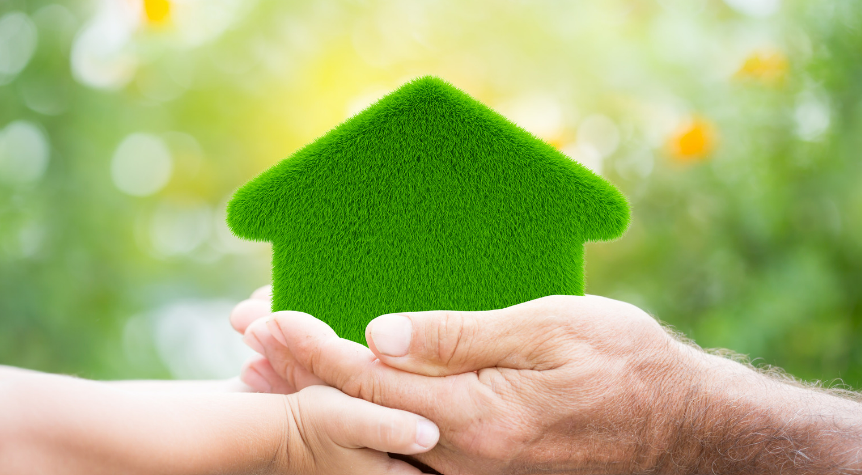With environmental concerns being at the forefront of global consciousness, the concept of eco-friendly interior design has gained significant traction. People are becoming increasingly aware of the impact their lifestyle choices have on the planet. Creating a growing demand for sustainable alternatives in all aspects of life, including home décor and design.
You don’t need to sacrifice style or comfort for an environmentally friendly home though! Sustainable interior design offers a variety of innovative solutions that not only reduce environmental impact, but also enhances the aesthetic appeal and functionality of living spaces.
Choose Sustainable Materials
When it comes to eco-friendly interior design, your choice in materials plays a pivotal role.
You want to choose organic materials such as bamboo, cork, reclaimed or sustainably sourced wood and recycled glass. These materials not only reduce the demand for virgin resources, but also minimises the carbon footprint associated with production and transportation.
You can incorporate these materials into your home in all manners of ways. From small decorative pieces to bamboo furniture and wood flooring. These materials not only add a touch of natural beauty to your home, but they also contribute to better indoor air quality.
Embrace Energy Efficiency
A cornerstone of sustainable design is energy efficiency. You should invest in energy-efficient appliances, LED lighting and other smart home technologies, which can significantly reduce energy consumption and your utility bills.
Additionally, proper insulation, high-performance windows, and passive solar design techniques can help regulate indoor temperatures. Reducing your need for heating and cooling systems.
Moreover, consider integrating renewable energy sources like solar power into your home. Installing solar panels coupled with an efficient solar energy storage solution can further enhance your energy independence and reduce reliance on traditional power grids.
Maximising Natural Light
Harnessing natural light not only contributes to an environmentally friendly environment, but it also enhances the overall ambience of your home.
You can design your home to maximise daylight through strategically placed windows, skylights and light tubes. This will reduce your reliance on artificial lighting during the day too! This not only reduces your reliance on artificial lighting during the day, but it also conserves energy and promotes a sense of well-being by connecting you to the natural world.
Incorporate Indoor Plants
A simple, yet effective, way to improve indoor air quality is by bringing nature indoors. Indoor plants act as natural air purifiers as they absorb harmful pollutants and release oxygen. Creating a healthier living environment as they add a touch of greenery to your home.

Plants can also serve as decorative elements as they add texture, colour and vitality to interior spaces.
Upcycle and Repurpose
Not only is it budget-friendly, but upcycling and repurposing old furniture and accessories is also eco-friendly.
Instead of discarding old items, consider giving them a new lease on life through creative refurbishment techniques. Whether its painting, reupholstering or repurposing furniture for a different function, upcycling allows you to reduce waste and infuse your home with unique, personalised touches.
Low-VOC Finishes
Traditional paints, varnishes and adhesives often contain volatile, organic compounds (VOCs), which can release harmful chemicals into the air. This contributes to indoor air pollution and can lead to health problems.
By choosing low-VOC or zero-VOC finishes and adhesives, you can significantly improve your indoor air quality and create a healthier living environment.
Invest in Sustainable Furniture
When furnishing your home, prioritise pieces that use sustainable materials and are manufactured using environmentally friendly practices. You should keep an eye out for furniture made from FSC-certified wood, reclaimed materials or eco-friendly alternatives. Additionally, choose durable furniture.

Pieces that are built to last, reducing the need for frequent replacements as well as minimising waste.
Support Local Artisans and Designers
Not only does it foster a sense of community, but by supporting your locals, you’re promoting sustainable practices too. By buying locally crafted good and handmade products, you can reduce the environmental impact associated with long-distance transportation.
Practice Water Conservation
Another aspect of eco-friendly living is conserving water. By incorporating water-saving fixates into your home, such as low-flow toilets, aerated faucets and water-efficient appliances, you can help minimise water usage. It also reduces utility costs! Additionally, if you capture rainwater for outdoor irrigation and landscaping, you can further reduce your reliance on water supplies.
Adopt a Minimalist Approach
If you embrace a minimalist approach with your interior design, you can reduce clutter and promote a sense of serenity. It will also minimise resource consumption and waste generation. Instead of filling your home with unnecessary items, you should focus on quality over quantity. Choosing items that serve a purpose, while still bringing joy to your space. Decluttering your home can also make cleaning and maintenance easier, further reducing environmental impact.






